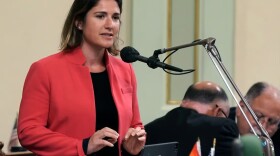President Trump is urging a “migrant caravan” to apply for asylum in Mexico rather than in the U.S., amid unprecedented dangers there. KPBS looks at the asylum-seekers already stuck in Tijuana, waiting for their turn to enter the San Ysidro Port of Entry.
As President Trump threatens to close the border in response to a mass exodus of Hondurans, hundreds of asylum-seekers already find themselves trapped in Tijuana, where police abuses against migrants are rampant and homicides are at an all-time high.
For more than a year, U.S. Customs and Border Protection (CBP) has been asking asylum-seekers who approach the San Ysidro Port of Entry, the country’s busiest land border crossing, to wait for an indefinite period before entering.
The agency says it does not have the capacity to process people as they come anymore, but it’s unclear why: while asylum claims have increased substantially, the port recently underwent a multi-million dollar expansion and ramped-up staffing. CBP declined to release information about how many people it can process at a time, or how that has changed.
These days, asylum-seekers who want to enter the U.S. legally must wait weeks, sometimes months in Tijuana before they can speak to U.S. immigration officials.
The lack of information has given rise to speculation from some of the region’s human rights defenders. Immigration attorney Nicole Ramos calls the capacity limitations a “lie,” and says the wait times are meant to discourage people from coming, like the family separation policy.
“They’re making it as miserable, heartbreaking, and terrifying as possible in order to deter them from arriving in the first place,” Ramos said.
Al Otro Lado, an advocacy group which Ramos works for, is suing the Department of Homeland Security in federal court in San Diego for turning away asylum-seekers. The U.S. Immigration and Nationality Act says people have a right to seek asylum in the U.S. International asylum law prohibits countries from sending people back to countries where they would face persecution.
Ramos says the U.S. practice of turning people away at the ports, even temporarily, is illegal — in part because they aren’t all safe in Mexico.
“We are placing people’s lives in incredible risk and there is no basis in law that allows for us to do that,” she said.

Unprecedented Dangers
In Tijuana, asylum-seekers face unprecedented dangers amid record violence. More than 2,000 people were killed so far this year, making it one of the bloodiest cities in the world. Asylum-seekers from Central America, often fleeing death threats from gangs that also operate in Mexico, are among the most vulnerable groups in a city that has long been hostile to migrants.
Human rights and religious groups offer food and beds in Tijuana shelters like Casa del Migrante and Desayunador Salesiano, but cartels and corrupt police have long preyed on non-white foreigners who find themselves on the street.
The director of Tijuana’s overcrowded morgue, Mercedes Quiroz, said about 70 percent of homicide victims are unidentified and unclaimed, probably because they’re migrants. “(The bodies) are not from here,” she said.
Criminal organizations specialize in kidnapping and extorting Central Americans. Hundreds of migrants have been found in clandestine graves. Most Central Americans won’t report crimes for fear of being deported by Mexican officials, who receive tens of millions of dollars from the U.S. to do just that.
Last year, Mexico’s immigration agency, INM, deported more than 78,000 Central Americans, including nearly 17,000 children. And it’s this agency that Customs and Border Protection is collaborating with to manage the flow of asylum-seekers through the San Ysidro Port of Entry.
On Oct. 24, KPBS witnessed INM officials direct more than a dozen asylum-seekers into vehicles as they waited outside the port for a chance to enter the U.S.
They were in a plaza known as El Chaparral, where asylum-seekers gather every morning beside vendors selling tamales and tabloids featuring photos of the latest bloodied bodies in Tijuana.
KPBS had interviewed some of the asylum-seekers earlier in the day, including Blanca Campozano, Edgar Valencia, their infant son and three-year-old daughter. They said they were seeking asylum from a cartel that had threatened them in the Mexican state of Michoacan.
Their family and others entered a yellow truck with the INM logo and an unmarked van with their backpacks and suitcases. A spokeswoman for INM told KPBS that Mexican officials were escorting the group to the port’s east entrance so they could request asylum in the U.S.
Customs and Border Protection did not respond to requests for comment about whether or not they made it into the U.S.

Legal Questions
President Trump has repeatedly stated that the exodus plans to enter the U.S. “illegally,” calling it an “invasion.”
On Twitter, he wrote, “Every time you see a Caravan, or people illegally coming, or attempting to come, into our Country illegally, think of and blame the Democrats.”
Members of the Honduran exodus say they’re fleeing violence and poverty and that they’re heading to the San Ysidro Port of Entry — the same port where another Trump-criticized “caravan” entered legally after long wait times.
Immigration attorneys like Ramos argue it’s the Trump administration that is breaking the law by turning away asylum-seekers. “It is intentional, it is nefarious, and it is highly illegal,” Ramos said.
The Department of Homeland Security’s Office of Inspector General (OIG) published a report last month, confirming CBP’s practice of turning away asylum-seekers due to alleged capacity issues.
“Although OIG observed asylum-seekers being turned away... CBP claimed that the processing facilities were full at those times,” the report states. “During our visits, OIG did not observe CBP turning away asylum-seekers while there was available space.”
The report also found that the so-called metering practice was contributing to more illegal border crossings, because people who couldn’t enter legally bypassed the ports.
The number of families and children asking for asylum at ports of entry in San Diego more than doubled this year from last year, and are up 44 percent from 2016.
Meanwhile, Border Patrol apprehended nearly 400,000 people crossing illegally in fiscal year 2018, an increase of about 100,000 people from the year before. Those numbers are on par with the annual numbers under Obama, and far less than the early 2000s.
The Notebook
It used to be that asylum-seekers would be allowed to live in the U.S. while Citizenship and Immigration Services investigated their claims. Now, those who approach the San Ysidro Port of Entry must put their names on an improvised wait list in a tattered notebook.
Asylum-seekers take turns managing the notebook with INM oversight. INM officials store the notebook for the asylum-seekers overnight. No one interviewed by KPBS was able to shed light on the origins of the notebook.
U.S. officials tell Mexican officials when they’re ready for more asylum-seekers, and how many. Mexican officials then tell the asylum-seekers, who consult the notebook. It’s confusing and tense.

“Please move that way, otherwise we’re going to close the notebook and nobody is going to pass!” cried the temporary notebook manager on Aug. 24 as she read out names, a crowd closing in around her.
She declined to give her name, saying she feared for her life. Most people declined to be interviewed on-camera for the same reasons, a situation KPBS hadn’t encountered before this year.
This scene plays out every day starting at around 7 a.m. in the outdoor plaza south of the port, El Chaparral, a stone’s throw from the gates leading into the U.S.
New arrivals form a line to put their names in the notebook. Those whose names are already on the list stand or sit in clusters, waiting to see if their names are called. As the asylum-seekers self-organize, people with visas and passports enter the port freely.
“Remember, they gave us the opportunity to pass 50 people today... let’s not waste the opportunities they give us!” says the day’s notebook manager.
Suddenly, one asylum-seeker approaches the notebook manager and begins speaking rapidly. Her name is Ana Jaimes. She’s a Mexican asylum-seeker who put her family’s names in the notebook two weeks ago.
Like everyone else, she’s been waiting to be called. But her seven-year-old has microcephaly and heart issues. Waiting in the sun every day has aggravated his health issues. He’s having trouble breathing. A blue mask over his face is marred with something that emerged from his lungs. Jaimes asks the group if she can cut in line.
“My son can’t be in the sun. He can’t do things like other boys. He’s the boy with the mask over his face,” she shouts into the crowd.
The asylum-seekers go back and forth, some not understanding. Not everyone speaks Spanish. Those who speak multiple languages become translators. On previous days, people have used smartphone apps to translate.
Some are concerned. Their own lives are at risk. But ultimately, they put their fears aside and decide to let the family cut in line to save the boy’s life. Jaimes agreed to an on-camera interview because she knows she’s safe.
“I’m so happy and grateful they’re letting us pass,” she says. She crossed that afternoon, and was released from custody with her children. But the others stayed in Mexico, where their lives remain at risk.
A Honduran Teen And ‘El Diablo’
In August, KPBS interviewed a 16-year-old from Honduras whose case exemplifies the risks asylum-seekers face on their journey to the U.S. — even after entering.
She asked us to call her Gabriela because she feared for her life in Mexico: “I think they can find me here, just like in Honduras. I’m scared even though I’m far away.”
Gabriela’s journey, she says, started a year ago at a school in Honduras, where she got a message from a local cartel boss, El Diablo, through her classmates, his associates.
“They asked if I could see him. But who wants to meet a person from a gang? I just ignored them,” she said.
When she got pregnant by her boyfriend, El Diablo’s associates came to her with another message: they were going to kill her unborn child. “They weren’t going to let the boy be born,” she said.
Terrified, Gabriela hopped on a bus to the U.S. Her boyfriend said he would catch up. But he never did and instead, broke up with her over the phone. She gave birth to her son alone, in a bathroom somewhere in southern Mexico. She named him Johandri.
Together, Gabriela and Johandri joined a caravan of asylum-seekers they ran into in Chiapas — the one that provoked the wrath of President Trump this spring.
When the caravan arrived at the border, she thought they were safe. But then she heard the Trump administration was taking babies from parents once they entered the U.S. She realized she had nothing to prove her child was hers.
“I couldn’t turn myself in because I don’t have the boy’s birth certificate,” she said.
Although Gabriela feared for her life in Mexico, she realized she had to wait until she could get the baby’s documents through Mexico’s child protective services.
She didn’t want to risk losing her son to the U.S government — not after saving him from the gang in her hometown. Johandri was all she had.
Volunteers at the YMCA shelter in Tijuana helped Gabriela navigate the bureaucracy, to protect her from deportation.
After nearly six months of waiting and hiding in Tijuana, Gabriela crossed into the U.S. with her baby.
But now, Gabriela faces yet another hurdle while pleading her asylum case: Attorney General Jeff Sessions has moved to deny asylum to people fleeing gang violence.
So while she escaped death and family separation, she may still end up deported back to El Diablo.








